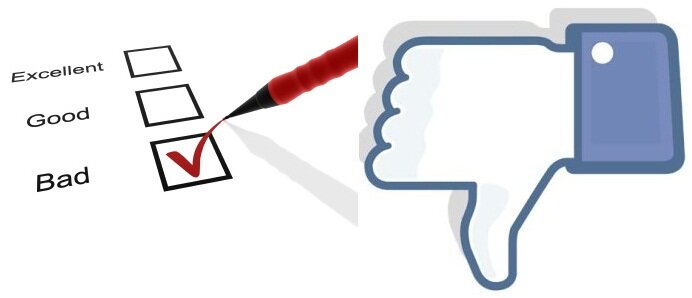
With the evolution of internet and social media, people no longer have to drop notes in a ‘suggestion-box’ installed within a company’s premises hoping that his/her complaint will be addressed. Nor does a customer have to just restrict his/her immediate family and friends from using the services of a certain brand after a particularly harrowing experience. Today’s customer has discovered the power of anonymity and posting reviews about services online. And as evident from the sheer volume of data on social media platforms and platform websites, the customer has a lot to say – both negative and positive.
User generated content has evolved at a breakneck pace and brands have started taking note of it; they have realized its importance and the necessity of engaging with their customers. While some brands have adopted scare tactics by using an IT law, which at best can be described as vague, to threaten platform websites and social media platforms into taking down negative reviews, others have given a whole new meaning to the phrase ‘Silence is golden’ by totally ignoring negative reviews. Still others have publicly tried to take away the credibility of a negative reviewer with counter-attack strategies.
The trouble with addressing negative reviews is that there are too many forums to express unhappiness over a certain brand. Dissatisfied customers have the option of posting reviews on social media and platform websites, discuss them on discussion forums, post blogs etc. Infact, in our research for this feature, we came across a website dedicated to negative reviews of a popular Indian pizza chain.
The problem most brands and their customers face in India is that laws concerning internet and censorship are not very clearly defined.
 “These laws have been misused in a very strange way in India. In the rest of the world, it has been mostly used to restrict sexually related content, while in India, it has been used for what might be business or political sentiments. Essentially, it is so vaguely defined that anybody can take any action on it; it is used as a political and business tool,” says Mahesh Murthy, the founder of digital brand management company Pinstorm.
“These laws have been misused in a very strange way in India. In the rest of the world, it has been mostly used to restrict sexually related content, while in India, it has been used for what might be business or political sentiments. Essentially, it is so vaguely defined that anybody can take any action on it; it is used as a political and business tool,” says Mahesh Murthy, the founder of digital brand management company Pinstorm.
The impact of negative reviews
There are no standard statistics on the extent of damage caused by negative reviews. While one research we came across claimed that 3 negative reviews can make 75% of the consumers reconsider their purchasing decision, another revealed that four out of every five people who read negative reviews about a product/service reverse their decision to buy it.
The results of these surveys, however, are enough to understand that the impact of negative reviews is huge.
 Faisal Farooqui, the CEO of MouthShut.com tells us that in a figure they analyzed internally, they found out that the ratio of people who read negative reviews to those who read positive ones is 10:1.
Faisal Farooqui, the CEO of MouthShut.com tells us that in a figure they analyzed internally, they found out that the ratio of people who read negative reviews to those who read positive ones is 10:1.
“What we have noticed is that a negative review is usually read by 500-5000 people, while a positive review is read by just 50—500 people. In our internal analysis, we found out that even one negative review can have a lot of impact on the brand and its reputation,” he says.
 Saurabh Parmar, Founder & CEO at Brandlogist Communications Consultancy says the impact of every negative review is not the same.
Saurabh Parmar, Founder & CEO at Brandlogist Communications Consultancy says the impact of every negative review is not the same.
“Social media is a lot like the real world except it is more viral in nature. Like the real world the identity of the negative reviewer, how big an influencer he or she is, the kind of facts they back their negative reviews with to the number of people supporting the review are all factors that influence the impact of negative reviews,” he says.
 Avijit Arya, Chairman and CEO of digital agency Internet Moguls, says that the buying decision of a “prospective” customer is based on what others have said about the brand in question.
Avijit Arya, Chairman and CEO of digital agency Internet Moguls, says that the buying decision of a “prospective” customer is based on what others have said about the brand in question.
“The revolution in media came up because everything good or bad started going viral and reaching a larger audience sooner than ever before, so an adverse review surely has the power to influence,” he says.
He, however, adds that one or two negative responses don't break a brands reputation.
“Reviewers and review sites have been understood now and not a new phenomenon any more. Smarter customers realise that and mostly they look at the overall mix of reviews to make a safer decision for themselves,” he says.
Negative reviews and ‘legal’ notices
The disturbing new trend in the online world is a brand’s resolve to curb negative reviews without addressing them. Due to the provisions of the Indian laws concerning the online space, any private individual can send a legal notice to a website to take down “objectionable” content.
“In 98% of the cases, people actually took their posts down even though the law says that when you get a notice, you either take it down or you challenge it. While the receiving party should have the guts to say that no, I am not taking this down, let us meet in court, more often than not, they just take it down,” Mahesh Murthy says.
The end result is that the law has become a tool of intimidation.
“A private individual sends another private individual a take-down notice. The trouble is that not enough people are calling the bluff and asking the notice sender to come to court,” Murthy adds.
Faisal Farooqui of MouthShut says that in case of negative reviews on their site, brands first get in touch with them, requesting a take-down, then a legal notice is sent and then the threats start.
“We tell brands that if they feel a particular review is harming their reputation, they can approach a court of law and get an order against it. If a court directs us to remove a review, we would be happy to comply,” he says.
“So far, only two judges in India have given orders to remove reviews on MouthShut. Of these two, in one case, it was more like a stay-order, where we had to remove the review for a few weeks. Our premise is that review is not about defamation, damage or reputation but it is about curbing people’s right to free speech,” he adds.
Saurabh Parmar of Brandlogist terms the tactic of sending legal notices “silly”.
“The message is already out there; people have read it. On the internet just by removing a piece of history, we are not really deleting anything because the message has been ingrained in people’s minds. Rather I would encourage a transparent dialogue,” he says.
Anonymous reviews
The jury is still out on whether or not to do away with anonymous reviews. While some experts say doing away with anonymity will result in witch-hunting and harassment of negative reviewers, others argue that anonymity can be used by rival brands or fake users to damage the reputation of brands.
Avijit Arya of Internet Moguls claims that brands only have issues with reviews that might be from people might not have been customers at all.
“Maybe brands would not mind reviews from identified customers with a proof of purchase of service to maintain authenticity of the reviewer and remove beyond doubt that the review in question could be competitor driver or false in nature,” he says.
Faisal Farooqui says even though MouthShut doesn’t allow people to post anything without registering or using Facebook login, he believes that anonymous reviews should not be done away with.
“If you take away the anonymity, then there could be harassment and witch-hunting by brands. Infact, we have documentation of brands approaching customers directly threatening them to remove their reviews,” he claims.
Mahesh Murthy finds nothing wrong with anonymous comments.
“I think in the online world, you need to have a thick skin, if you don’t have it, don’t come online,” he opines.
What brands should do in case of negative reviews
Citing the example of a multi-national bank, Mahesh Murthy says that many brands don’t want to address negative reviews because they don’t want to be responsible.
“We told a multi-national bank that they should adopt reputation management to counter a significant volume of negative reviews it had garnered. They refused saying that if they start a programme to address these reviews, then they will have to be responsible and actually follow-up and monitor these and future reviews,” he says, adding, “This bank will go from bad to worse, while banks which undertakes reputation management, will receive better consumers.”
Saying that brands should immediately intervene, acknowledge, be polite and ask for the cause of a negative review, he adds that customers are not seeking perfection, they just want to see that brands are responsible and responsive.
Avijit Arya of Internet Moguls gives a three-point solution to brands to deal with negative reviews:
1. Respond in a timely manner
2. Address the concern in question
3. Thank them and assure them of corrective action
He says that while doing this, a brand satisfies not just the existing reviewer but the other 10 who might be looking at the review to make a decision.
“Offensive negative adverse reviews and feedback has always been a part of a brands lifecycle, being online it is just bigger and can make a deeper impact. Hence, ideally these should not be taken personally and should be replied to with respect for the reviewers concern and assurance that they have been heard. Reviewers offline or online go negative mostly if the customer feels their concerns have not been heard and they then approach platforms to voice their opinions,” he says.
Saurabh Parmar of Brandlogist says that the feedback should be analyzed and the brand should engage the negative reviewer.
"Data tells us that a customer who gave a negative review & has a subsequent positive experience because of the brand's intervention has a higher chance of being a repeat customer. Brands should not be scared of criticism because at the end of the day customers will always have their perspective. The only choice a brand has is to participate in the conversation & subsequently learn & improve or remain indifferent to what their own customers or prospective customers are saying," he says.






